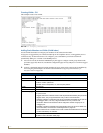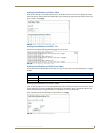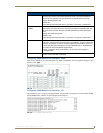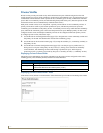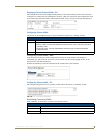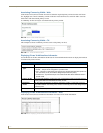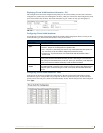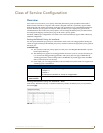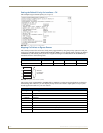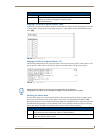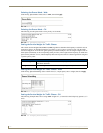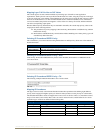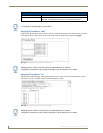
VLAN Configuration
135
NXA-ENET24 - Software Management Guide
Displaying Private VLAN Interface Information - CLI
This example shows the switch configured with primary VLAN 5 and secondary VLAN 6. Port 3 has been
configured as a promiscuous port and mapped to VLAN 5, while ports 4 and 5 have been configured as a host
ports and associated with VLAN 6. This means that traffic for port 4 and 5 can only pass through port 3.
Configuring Private VLAN Interfaces
Use the Private VLAN Port Configuration and Private VLAN Trunk Configuration menus to set the private
VLAN interface type, and associate the interfaces with a private VLAN.
Configuring Private VLAN Interfaces - Web
Click Private VLAN, Private VLAN Port Configuration or Private VLAN Trunk Configuration. Set the
PVLAN Port Type for each port that will join a private VLAN. For promiscuous ports, set the associated
primary VLAN. For host ports, set the associated secondary VLAN. After all the ports have been configured,
click Apply.
FIG. 150 CLI - Displaying Private VLAN Port Information
Command Attributes
•Port/Trunk: The switch interface.
• PVLAN Port
Type:
Sets the private VLAN port types.
• Normal – The port is not configured into a private VLAN.
• Host – The port is a community port and can only communicate with other ports in its
own community VLAN, and with the designated promiscuous port(s).
• Promiscuous – A promiscuous port can communicate with all interfaces within a
private VLAN.
• Primary VLAN: Conveys traffic between promiscuous ports, and between promiscuous ports and com-
munity ports within the associated secondary VLANs. If PVLAN type is “Promiscuous,”
then specify the associated primary VLAN. For “Host” type, the Primary VLAN displayed
is the one to which the selected secondary VLAN has been associated.
• Secondary
VLAN:
On this switch, all secondary VLANs are community VLANs. A community VLAN con-
veys traffic between community ports, and from community ports to their designated pro-
miscuous ports. If PVLAN Port Type is “Host,” then specify the associated secondary
VLAN.
FIG. 151
Web - Private VLAN Port Configuration




